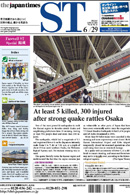Essay
Atsuta's new roadside station
The roadside station (michi-no-eki) network is one of the best reasons for traveling by car in Japan that I can think of. Like service areas and parking areas, roadside stations offer parking space, public toilet facilities and a place for weary drivers and passengers to buy food and drink. But roadside stations are usually located in rural communities, along the narrower rural highways. They serve the needs of long-distance travelers, but they also exist to serve and energize the local community.
A new roadside station will open this month just down the road from my studio in old Atsuta village (now merged into Ishikari city). It is located about an hour north of Sapporo along the Japan Sea coast. The project team entrusted with bringing the new roadside station to life is called Ai-Kaze. The name is meant to conjure a refreshing breeze (kaze) that transports love (ai), new encounters (ai) and personal dreams (I).
Ai-Kaze is headed by Kazuhiko Yoshida, who is convinced that the region is full of treasures that wait to be dug up and polished. All products and food sold at the roadside station will be caught, grown, produced or manufactured within the Ishikari region. You won't find famous food brands like Shiroi Koibito or Royce' that tourists often pick up from the airport gift shops just before they fly out of Shin-Chitose Airport. But you will find great local, seasonal products with an Atsuta-specific twist.
When Yoshida says "treasures," he doesn't just mean "things." Hands-on experiences of the local culture may also be part of a roadside station's program. For example, some michi-no-eki give you the chance to take part in dragnet seine fishing events, in which large numbers of visitors can help drag a huge net full of fish onto the shore. This is often followed by a fish-grilling party on the beach.
The significance of the Ishikari coast in the history and development of northern Japan is another local treasure of the new Atsuta roadside station. Informative dioramas of the once-booming herring fishing industry and Kitamae trading ships occupy one section of the main building. There are also displays of local ecosystems, including the seashore and thickly wooded mountains.
Beautiful sunsets are a well-known treasure of the Ishikari coast, especially around Atsuta. Perhaps the most dynamic aspect of the michi-no-eki are the huge picture windows that wrap around two sides of the second floor for the purpose of admiring these sunsets. The third floor offers another sunset-viewing deck. All floors are wheelchair-accessible.
As of last November, there were 1,134 roadside stations in Japan, and when the Atsuta roadside station opens on April 27, it will be the 120th roadside station in Hokkaido.
Why not add Hokkaido to your Golden Week plans, and watch the sunset from the Atsuta michi-no-eki?
厚田の新しい道の駅
石狩市厚田区にある筆者のアトリエ近くに今月、新しい道の駅がオープンする。地元の物産や観光の魅力がぎゅっと詰まった新しい憩いの場になりそうだ。
The Japan Times ST: April 27, 2018
The Japan Times ST 読者アンケート
この記事のご感想をお聞かせください。





